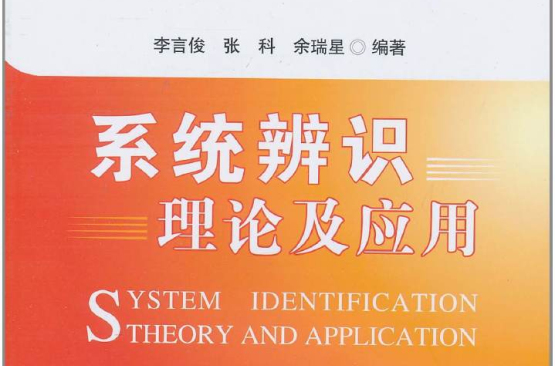基本介紹
內容簡介,目錄,
內容簡介
《系統辨識理論及套用》主要闡述系統辨識的基本原理以及套用。《系統辨識理論及套用》共分14章。第1章至第4章為緒論、系統辨識常用輸入信號、線性系統的經典辨識方法和動態系統的典範表達式,主要回顧和介紹了與系統的辨識有關的一些基礎知識。第5章至第12章為最小二乘法辨識、極大似然法辨識、時變參數辨識方法、多輸入一多輸出系統的辨識、其他一些辨識方法、隨機時序列模型的建立、系統結構辨識和閉環系統辨識等,介紹了系統辨識常用基本方法,是系統辨識的主要內容。第13章和第14章分別介紹了系統辨識在飛行器參數辨識中的套用和神經網路在系統辨識中的套用。
目錄
Chapter 1 Introduction
1.1 Classification of Mathematic Models of System and Modelling Methods
1.1.1 Signification of Model
1.1.2 Representation Forms of Models
1.1.3 Classification of Mathematic Models
1.1.4 Basic Methods to Establish Mathematic Model
1.1.5 Basic Principles Followed for Modeling
1.2 Definition, Content and Procedure of Identification
1.2.1 Definition of Identificauon
1.2.2 Content and Procedure of Identification
1.3 Error Criteria Usually Used in Identification
1.3.1 Output Error Criterion
1.3.2 Input Error Criterion
1.3.3 Generalized Error Criterion
1.4 Classification of System Identification:
1.4.1 Off-line Identification
1.4.2 On-line Identification
Problems
Chapter 2 Commonly Used Input Signals for System Identification
2.1 Selective Criteria of Input Signal for System Identification
2.2 White Noises and Its Generating Methods
2.2.1 White Noise Process
2.2.2 White Noise Sequence
2.2.3 Generating Methods of White Noise Sequence
2.3 Generation of Pseudorandom Binary Sequence——M-Sequence and Its Properties
2.3.1 Pseudorandom Noise
2.3.2 Generating Method of M-Sequence
2.3.3 Properties of M-Sequence;
2.3.4 Autocorrelation Function of Two-Level M-sequence
2.3.5 Power Spectral Density of Two-Level M-sequence
Problems
Chapter 3Classical Identification Methods of Linear System
3.1 Identify Impulse Response of Linear System by Use of M-Sequence
3.2 Obtain Transfer Function from Impulse Function,
3.2.1 Transfer Function G(s) of Continuous System
3.2.2 Transfer Function of Discrete System——Impulse Transfer Function G(z-1 )
Problems
Chapter 4 Canonical Expression of Dynamic Systems
4.1 Parsimony Principle~
4.2 Representations of Difference Equation and State Equation of Linear System
4.2.1 Representation of Difference Equation of Linear ,Time-Invariant System
4.2. 2Representation of State Equation of Linear System
4.3Deterministic Canonical State Equations
4.3.1 Controllable Form of Canonical State Equation
4.3.2 Controllable Form of Canonical State Equation
4.3.3 Observable Form of Canonical State Equation I
4.3.4 Observable Form of Canonical State Equation II
4.3.5 Observable Form of Canonical State Equation I of Mimo System
4.3.6 Observable Form of Canonical State Equation II of Mimo System
4.4 Deterministic Canonical Difference Equationsr
4.5 Stochastic Canonical State Equations
4.6 Stochastic Canonical Difference Equations
4.7 Prediction Error Equation
Problems
Chapter 5 Least-Squares Identification
5.1 Least Square Method
5.1.1 Algorithns of Least2Square Estimation
5.1.2 Input Signals for Least-Squares Estimation
5.1.3 Probability Properties of Least-Squares Estimation
5.2 A Kind of Least Squres Which Need Not Invert Matrix
5.3 Recursive Least Squares
5.4 Auxiliary Variable Method
5.5 Recursive Auxiliary Variable Method
5.6 Generalized Least Squares
5.7 An Alternative Generalized Least Squares Technique (Hsia Method)
5.8 Extended Matrix Method
5.9 Multistage Least Squares
5.9.1 The First Algorithm
5.9.2 The Second Algorithm
5.9.3 The Third Algorithm
5.10 Fast Multistage Least Squares Problems
……
1.1 Classification of Mathematic Models of System and Modelling Methods
1.1.1 Signification of Model
1.1.2 Representation Forms of Models
1.1.3 Classification of Mathematic Models
1.1.4 Basic Methods to Establish Mathematic Model
1.1.5 Basic Principles Followed for Modeling
1.2 Definition, Content and Procedure of Identification
1.2.1 Definition of Identificauon
1.2.2 Content and Procedure of Identification
1.3 Error Criteria Usually Used in Identification
1.3.1 Output Error Criterion
1.3.2 Input Error Criterion
1.3.3 Generalized Error Criterion
1.4 Classification of System Identification:
1.4.1 Off-line Identification
1.4.2 On-line Identification
Problems
Chapter 2 Commonly Used Input Signals for System Identification
2.1 Selective Criteria of Input Signal for System Identification
2.2 White Noises and Its Generating Methods
2.2.1 White Noise Process
2.2.2 White Noise Sequence
2.2.3 Generating Methods of White Noise Sequence
2.3 Generation of Pseudorandom Binary Sequence——M-Sequence and Its Properties
2.3.1 Pseudorandom Noise
2.3.2 Generating Method of M-Sequence
2.3.3 Properties of M-Sequence;
2.3.4 Autocorrelation Function of Two-Level M-sequence
2.3.5 Power Spectral Density of Two-Level M-sequence
Problems
Chapter 3Classical Identification Methods of Linear System
3.1 Identify Impulse Response of Linear System by Use of M-Sequence
3.2 Obtain Transfer Function from Impulse Function,
3.2.1 Transfer Function G(s) of Continuous System
3.2.2 Transfer Function of Discrete System——Impulse Transfer Function G(z-1 )
Problems
Chapter 4 Canonical Expression of Dynamic Systems
4.1 Parsimony Principle~
4.2 Representations of Difference Equation and State Equation of Linear System
4.2.1 Representation of Difference Equation of Linear ,Time-Invariant System
4.2. 2Representation of State Equation of Linear System
4.3Deterministic Canonical State Equations
4.3.1 Controllable Form of Canonical State Equation
4.3.2 Controllable Form of Canonical State Equation
4.3.3 Observable Form of Canonical State Equation I
4.3.4 Observable Form of Canonical State Equation II
4.3.5 Observable Form of Canonical State Equation I of Mimo System
4.3.6 Observable Form of Canonical State Equation II of Mimo System
4.4 Deterministic Canonical Difference Equationsr
4.5 Stochastic Canonical State Equations
4.6 Stochastic Canonical Difference Equations
4.7 Prediction Error Equation
Problems
Chapter 5 Least-Squares Identification
5.1 Least Square Method
5.1.1 Algorithns of Least2Square Estimation
5.1.2 Input Signals for Least-Squares Estimation
5.1.3 Probability Properties of Least-Squares Estimation
5.2 A Kind of Least Squres Which Need Not Invert Matrix
5.3 Recursive Least Squares
5.4 Auxiliary Variable Method
5.5 Recursive Auxiliary Variable Method
5.6 Generalized Least Squares
5.7 An Alternative Generalized Least Squares Technique (Hsia Method)
5.8 Extended Matrix Method
5.9 Multistage Least Squares
5.9.1 The First Algorithm
5.9.2 The Second Algorithm
5.9.3 The Third Algorithm
5.10 Fast Multistage Least Squares Problems
……

